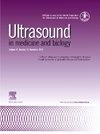SDRD-Net: A Symmetric Dual-branch Residual Dense Network for OCT and US Image Fusion
IF 2.4
3区 医学
Q2 ACOUSTICS
引用次数: 0
Abstract
Ultrasound (US) images have the advantages of no radiation, high penetration, and real-time imaging, and optical coherence tomography (OCT) has the advantage of high resolution. The purpose of fusing endometrial images from optical coherence tomography (OCT) and ultrasound (US) is to combine the advantages of different modalities to ultimately obtain more complete information on endometrial thickness. To better integrate multimodal images, we first proposed a Symmetric Dual-branch Residual Dense (SDRD-Net) network for OCT and US endometrial image fusion. Firstly, using Multi-scale Residual Dense Blocks (MRDB) to extract shallow features of different modalities. Then, the Base Transformer Module (BTM) and Detail Extraction Module (DEM) are used to extract primary and advanced features. Finally, the primary and advanced features are decomposed and recombined through the Feature Fusion Module (FMM), and the fused image is output. We have conducted experiments across both private and public datasets, encompassing IVF and MIF tasks, achieving commendable results.
SDRD-Net:用于OCT和US图像融合的对称双分支残差密集网络。
超声(US)图像具有无辐射、高穿透性和成像实时性的优点,光学相干断层扫描(OCT)具有高分辨率的优点。融合光学相干断层扫描(OCT)和超声(US)子宫内膜图像的目的是结合不同方式的优势,最终获得更完整的子宫内膜厚度信息。为了更好地整合多模态图像,我们首先提出了用于OCT和US子宫内膜图像融合的对称双分支残余密度(SDRD-Net)网络。首先,利用多尺度残差密集块(MRDB)提取不同模态的浅层特征;然后,使用基本变压器模块(BTM)和细节提取模块(DEM)提取基本特征和高级特征。最后,通过特征融合模块(Feature Fusion Module, FMM)对原始特征和高级特征进行分解和重组,输出融合后的图像。我们在私人和公共数据集上进行了实验,包括IVF和MIF任务,取得了值得称赞的结果。
本文章由计算机程序翻译,如有差异,请以英文原文为准。
求助全文
约1分钟内获得全文
求助全文
来源期刊
CiteScore
6.20
自引率
6.90%
发文量
325
审稿时长
70 days
期刊介绍:
Ultrasound in Medicine and Biology is the official journal of the World Federation for Ultrasound in Medicine and Biology. The journal publishes original contributions that demonstrate a novel application of an existing ultrasound technology in clinical diagnostic, interventional and therapeutic applications, new and improved clinical techniques, the physics, engineering and technology of ultrasound in medicine and biology, and the interactions between ultrasound and biological systems, including bioeffects. Papers that simply utilize standard diagnostic ultrasound as a measuring tool will be considered out of scope. Extended critical reviews of subjects of contemporary interest in the field are also published, in addition to occasional editorial articles, clinical and technical notes, book reviews, letters to the editor and a calendar of forthcoming meetings. It is the aim of the journal fully to meet the information and publication requirements of the clinicians, scientists, engineers and other professionals who constitute the biomedical ultrasonic community.

 求助内容:
求助内容: 应助结果提醒方式:
应助结果提醒方式:


